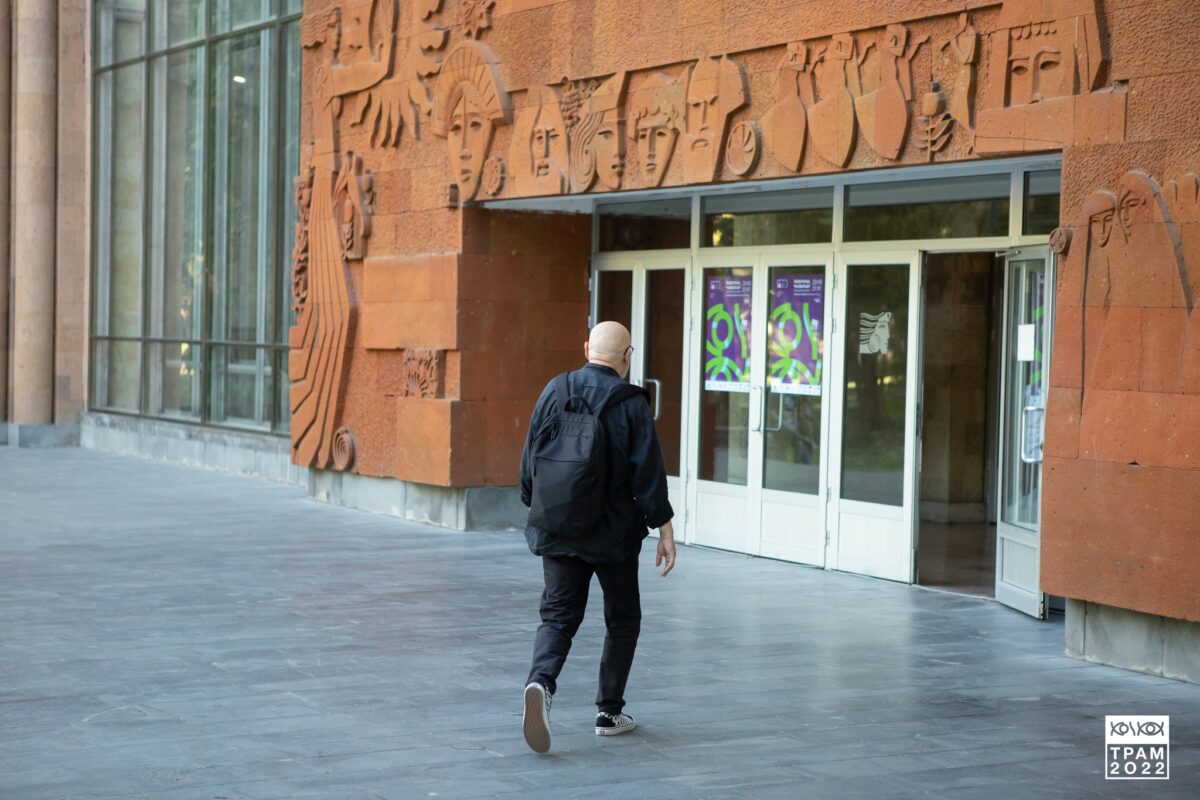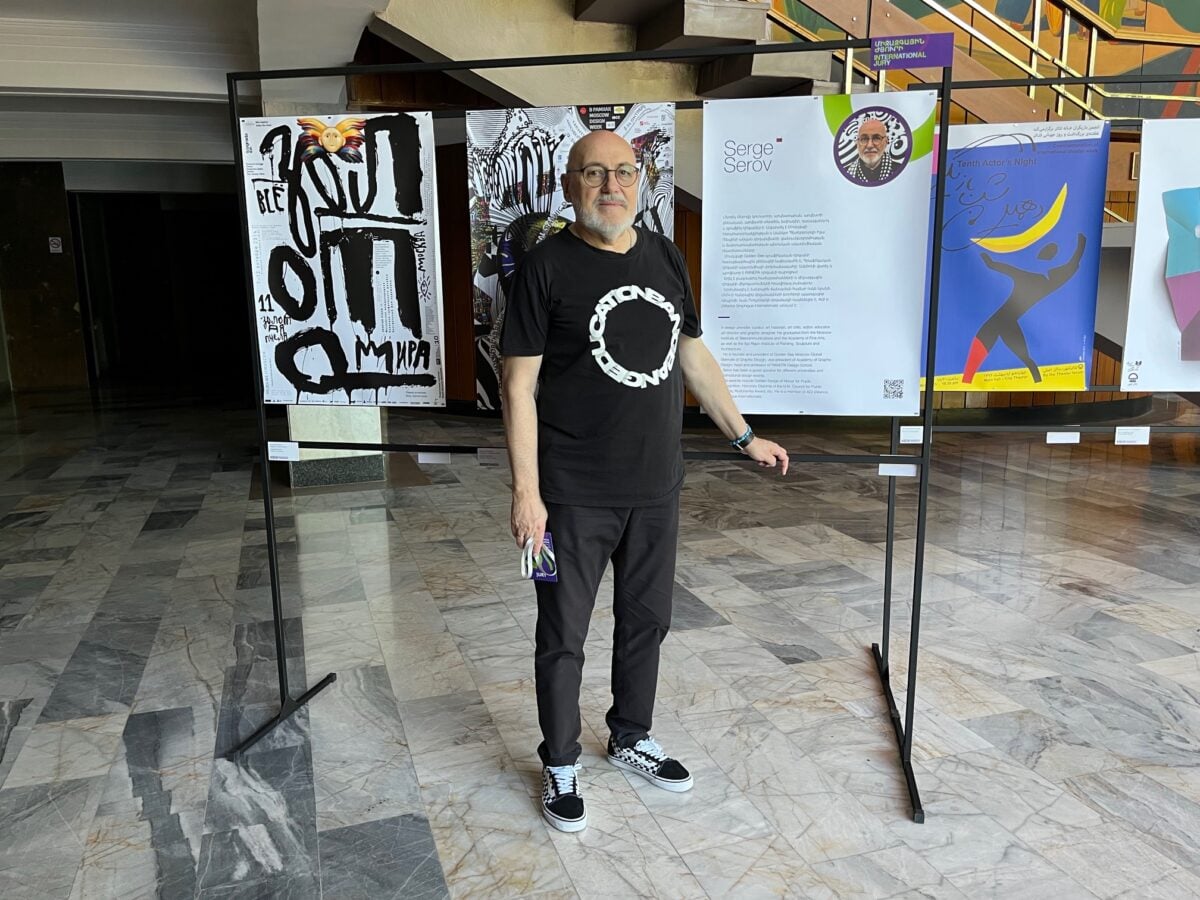The Theatrical Posters’ festival/competition took place in Armenia, which for the first time brought together visual artists working in the field of poster art around the idea of theater.
The international jury of the festival included the chairman of the “Golden Bee” fund for the development and support of Russian graphic design and the biennale of the same name, a great connoisseur of poster art, and designer Sergey Serov.
He considers the poster a laboratory of fresh visual language. Especially since now, many things are directly related not only to aesthetics but also to ethics.
Sergey Serov suggests not forgetting about light, which is an important factor in any message. And it is no coincidence that the roots of enlightenment and illumination (lat. lumen meaning light) are also light. In other words, the art of highlighting. In his opinion, the modern poster also tries to be alive and illuminating, in contrast to, let’s say, dulling and emptying propaganda.
If we talk not about a purely illustrative role (a visual accompaniment to a theater, cinema, or any other event), but a broader, condensed public reflection, how has the role of poster art changed? The poster has an effect quickly because the digital environment itself is a poster, a field of short, precise, and memorable messages.
In general, it is an important question what is considered modern in poster art and what happened before then?
I organize a biennale in Moscow, which turned 30 years old this year. And in science, 30 years is the period after which modern ends and history begins. During those years, the changes accumulate and pile up and seem to transform reality with a bang.
The last 30 years have coincided with the jubilee of our biennale and a new period, which is new both technologically and politically.
In poster art, there were changes in language, culture, and politics. And it all happened at the same time.
The “Golden Bee” was born when the Iron Curtain collapsed, then we reached the digital revolution step by step, passing in parallel through revisions of political and natural achievements (Chornobyl, other ecological disasters). All of these were parallel processes that can be called postmodern in a broad sense, but in any case, a thin line was drawn that separated the old Soviet poster from the new forms.
And it is like that all over the world. For example, exactly 30 years ago, all the cities of the world switched to a new lighting model. Widespread evening lighting appeared in the cities, that is, the goal was set that the evening should be as bright as the day and there should be no hidden secrets, even under the bed.
It is a very striking image. Local light spots disappeared in cities (remember the image of a window lit by a candle or a lampshade), and total lighting came to replace it when day and night were no longer distinguishable.
It is the light that replaced the objective perception of cities and all of us with a subjective one. The power of the weak came, which, thanks to the additional illumination, became strong as well.
The poster, which used to aggressively urge, say, to volunteer for the army or to fly Aeroflot planes, gave way to an inviting rather than a commanding message.
The new poster attracts attention and even promises a magical transformation thanks to illumination.
There is a joke among filmmakers. Two enlighteners meet, one asks: are you getting married, what kind of woman is she? The other answers, it depends on how you put a light on it.
In other words, the question is really how you place the light and what you emphasize with it.
It is probably the same in today’s mixed information environment. Whatever case you cover, whoever’s words you pay attention to, that’s how it will appear. How have the messages of posters changed?
Before, the message was a monologue: fast, understandable, unambiguous, and aggressive. And now it’s just like the lighting of buildings (how will you place the light). It is possible to illuminate one part, and also the other. And it will turn out that the same building appears in the field of subjective perception and is no longer ambiguous.
The atmosphere that the poster conveys is more important than the message itself. As literary people say, context is more important than text.
What was a medium in the poster (emotions, palette) comes to the fore, and now in the poster, we can perceive the visuality that has departed from modern art.
Modern art still ignores visuality and creates art by playing with any household object (say, a nail). And that is the reason why the word “beauty” has already been left out of the vocabulary of art.
And in the poster, on the contrary, beauty came to the fore. It is the poster that preserves and stops this lost visuality to some extent.
Apart from the fact that the poster conveys feelings, atmosphere, and message, it also fills our eyes with plasticity and beauty.
And how important is the political component in the poster now?
If we talk about the language of the modern poster, then the political component is not important.
Any high-quality, creative poster is always against war, violence, and conflicts.
It is already created for the sake of peace, and creation. In other words, it is for life, not death. And that aspiration towards the bright can be seen in almost all the good posters that were presented both at our biennial and at the Yerevan festival.
That’s what is valuable in a high-quality poster, not the posts with which people go out to the streets for protests. Of course, these actions are very important, but now we are talking about the language of the modern poster.
And posters with direct political texts (slogans or colors of flags) are closer to the field of extreme activity.
Like the pictograms that show landmarks, which cannot be confused, for example, if the goal is the design of the women’s and men’s toilets. Or road signs, which should clearly indicate where to turn right or left. They should be quickly and unambiguously perceptible.
And yes, I think that now political posters, especially those related to war, appear in that extreme area where road signs and addresses written on doors live.

Can memorable and quality posters come from there?
From an anti-war poster, no. Rather, from the general crisis, which can be solved by the way out, to another level. Survived tragedy and survived emotions can become the basis for the birth of something new to say.
And those posters, with which people carry out actions, are needed only in the zone of extreme speech, where the “here and now” is important.
We hope it will be what happened after Auschwitz. Of course, now the end of our crisis is not in sight and it is unclear how long it will last, but sooner or later this nightmare will also end. And the poster will use extreme feelings, tension, and terrible experiences. We will clearly see that this is a post-war poster.
There may be such a trajectory, but it may also not be. It is always a secret.
Does a good poster live for centuries, or does it die quickly, assimilating into the culture?
Of course, it belongs to its time. We can, for example, admire the French poster, which was born in the 19th century, or the Polish poster art, which was born after the Second World War, and understand that it is already history.
They are pages of history, and we perceive them with a view framed by history itself. Yes, Europeans hang them on the walls as masterpieces and decorate cafes and town halls with them, but they are images of a different influence.
And what is bad taste? How does bad taste become dominant in the general visual noise?
I can explain it very simply. Bad taste is a dead art, which is always secondary, imitative, and already seen and digested a thousand times. When you see that although it exists as an object, it is not really included in the culture.
And seeing it, you stumble, break your gaze.
The work must have meaning, and it is not important at all what style, school, genre, or author it is. In that case, creativity will rise above the dull everyday life that surrounds us.
To what extent does propaganda continue to be a factor in Russia at war? There’s an impression that it is so detached from reality that it has made a mockery of itself.
Russian propaganda is criminal zombification. I can say that it is no longer propaganda, but the injection of the lowest quality passions. Everything below the waist is ugly and similar to the culture of “gopniks” (criminal circle).
The worst instincts that exist in a person are awakened and broadcast by the media and especially by the TV screen.
It just turns the world upside down. Propaganda still somehow differentiates between the upper and the lower, operates within certain limits, and what is happening in the media field of Russia can already be called only total lies and total zombification of the population.
It is already a medical phenomenon, not an aesthetic one.
But is it already exhausted or not yet?
Hell has no bottom.
Of course, this influence will definitely end. But it still continues to poison people’s spirits, eyes, and brains.
Why was it so easy to influence millions of people?
Because we could not remove ourselves from the Soviet period. There was no psychological or mental break from the past. There were a few years or even months in the 1990s when people really felt the need to draw dividing lines in front of the past.
But then everything went back to normal.
If there was, say, a trial of the communist party or a ban on the use of communist activities or symbols, there would be no need to falsify the elections in 1996 either. Or if we had initiated the process of property return, we would not have found ourselves in a state of wild redistribution of property.
But it was not done, the new train was placed on the old rails and was accompanied by this destructive propaganda.
The lower quality always appears first on the surface of the water. Including in every individual. A man can turn into a beast if you give him the chance.
And they gave him that opportunity. And the propaganda relied on the worst qualities in a person.

There is a great flight from Russia now, and many projects are being frozen. Will censorship return?
Censorship has already returned and is working in full force. And worse, self-censorship is back.
But I don’t think that it will last long, and we will find ourselves in the conventional USSR-2 for several decades. I don’t even believe that this situation can drag on for more than a year, the processes have accelerated a lot.
But this year’s “Golden Bee” was held with great difficulty, the Tretyakov Museum, which provided us with a hall, was trembling with fear that something would suddenly happen. The risk is that art can create associations. I was also asked: I’m sorry, of course, but maybe there are posters in the exhibition that can cause unwanted associations? I said yes, all of them.
And that really is true, because everything depends on how you put a light on it.
Interview by Nune Hakhverdyan
Photos by Ruben Martirosyan,
from the Theater Poster Festival page







